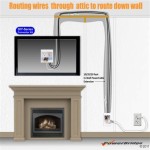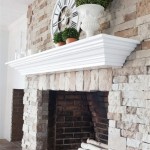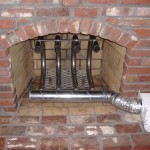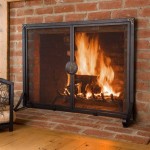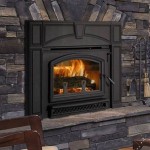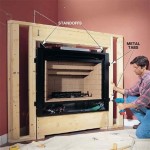Fireplace Chimney Flue Repair: A Comprehensive Guide
The fireplace chimney flue is a critical component of a home's heating system. It serves as a conduit for the safe and efficient removal of combustion byproducts, such as smoke, carbon monoxide, and creosote, from the fireplace to the outside atmosphere. Maintaining the integrity of the flue is paramount for safety and performance. A damaged or deteriorated flue can lead to a variety of problems, including chimney fires, carbon monoxide poisoning, and reduced heating efficiency. This article provides a comprehensive overview of fireplace chimney flue repair, covering common issues, repair methods, and preventative measures.
Understanding the Chimney Flue and its Importance
The chimney flue is essentially a liner within the chimney structure. It can be constructed from various materials, including clay tiles, metal, or cast-in-place concrete. The flue liner protects the chimney masonry from the corrosive effects of combustion gases. Without a proper flue liner, these gases can penetrate the brick or stone, leading to structural damage and eventual deterioration. Furthermore, a properly sized and functioning flue ensures adequate draft, which is necessary for efficient combustion and the prevention of smoke backdrafts into the home.
The flue's size and shape are determined by the fireplace's specifications and the type of fuel being burned. A flue that is too small can restrict airflow, leading to incomplete combustion and increased creosote buildup. Conversely, a flue that is too large can result in a cooler chimney temperature, which can also contribute to creosote formation. Regular inspections and maintenance are crucial to identify and address any issues before they escalate into more serious problems.
The National Fire Protection Association (NFPA) publishes comprehensive standards for chimney construction and maintenance. NFPA 211, in particular, addresses guidelines for chimney inspections, cleaning, and repair. Adherence to these standards is essential for ensuring the safety and longevity of the chimney system.
Common Chimney Flue Problems and Their Causes
Several factors can contribute to damage and deterioration of the chimney flue. These include:
*Creosote Buildup:
Creosote is a highly flammable byproduct of incomplete combustion. It accumulates on the inner walls of the flue and can ignite, causing a chimney fire. Inadequate cleaning and maintenance, burning unseasoned wood, and low chimney temperatures can all contribute to creosote buildup. *Water Damage:
Water penetration is a significant threat to chimney flues. Cracks in the chimney crown, damaged flashing, or missing bricks can allow water to enter the chimney structure. This water can freeze and thaw, causing the flue tiles to crack and crumble. Acidic rainwater can also corrode metal flues. *Thermal Shock:
Rapid temperature changes can stress the flue liner, particularly clay tiles. Repeated heating and cooling cycles can lead to cracking and spalling. *Settling and Foundation Issues:
Shifting foundations or general settling of the house can put stress on the chimney, leading to cracks in the flue and surrounding masonry. *Corrosion:
Metal flue liners are susceptible to corrosion from acidic combustion gases and moisture. This is particularly true in systems that burn fuels with high sulfur content.Recognizing the signs of these problems is crucial for timely intervention. Common indicators of flue damage include:
* Visible cracks or missing sections of the flue liner. * Spalling or crumbling of the flue tiles. * Water stains on the chimney or surrounding walls. * A strong odor of creosote in the house. * Smoke backdrafts into the home. * Debris falling from the chimney.If any of these signs are present, a professional chimney inspection is recommended to assess the extent of the damage and determine the appropriate course of action.
Chimney Flue Repair Methods
The appropriate repair method for a damaged chimney flue depends on the severity and nature of the problem. Several options are available, ranging from minor repairs to complete relining. The most common repair methods include:
*Flue Sealants:
For minor cracks and gaps in the flue liner, a sealant can be applied to create a temporary barrier. These sealants are typically heat-resistant and designed to withstand the harsh conditions within the chimney. However, sealants are generally not a long-term solution for structural damage. *Flue Tile Replacement:
Individual damaged flue tiles can be removed and replaced with new ones. This method is suitable for localized damage where the surrounding tiles are still in good condition. The process involves carefully removing the damaged tile, applying mortar to the surrounding tiles, and inserting the new tile in place. *Chimney Relining with Metal Liner:
This is a common and often recommended solution for significantly damaged or deteriorated flues. A new stainless steel or aluminum liner is inserted into the existing chimney. The liner is then connected to the fireplace and the chimney top. Metal liners offer several advantages, including durability, resistance to corrosion, and improved draft. They also provide a smooth inner surface, which reduces creosote buildup. There are two main types of metal liners: rigid and flexible. Rigid liners are used for straight chimney runs, while flexible liners are suitable for chimneys with offsets or bends. *Cast-in-Place Lining:
This method involves pouring a heat-resistant concrete mixture into the existing flue to create a new, seamless liner. This option is particularly effective for chimneys with irregular shapes or significant damage. A form is inserted into the flue, and the concrete mixture is poured around it. Once the concrete has cured, the form is removed, leaving a smooth, durable liner. *HeatShield® Joint Repair System:
This system is designed to repair mortar joints between flue tiles. It involves applying a ceramic sealant to the joints using a specialized applicator. This creates a smooth, continuous surface that prevents further deterioration and improves draft.Selecting the right repair method requires careful consideration of the chimney's condition, the homeowner's budget, and local building codes. A qualified chimney professional can assess the situation and recommend the most appropriate and cost-effective solution.
Preventative Maintenance for Chimney Flues
Preventative maintenance is essential for extending the life of the chimney flue and preventing costly repairs. Regular inspections, cleaning, and proper usage of the fireplace can significantly reduce the risk of damage and deterioration. Key preventative measures include:
*Annual Chimney Inspections:
A certified chimney sweep should inspect the chimney at least once a year to identify any potential problems. The inspection should include a visual examination of the flue liner, chimney crown, flashing, and other components. *Regular Chimney Cleaning:
Cleaning the chimney regularly removes creosote buildup and other debris. The frequency of cleaning depends on the frequency of fireplace use and the type of fuel being burned. NFPA 211 recommends cleaning the chimney when creosote buildup reaches 1/8 inch in thickness. *Burning Seasoned Wood:
Burning dry, seasoned wood reduces creosote buildup and improves combustion efficiency. Unseasoned wood contains more moisture, which leads to incomplete combustion and increased creosote formation. *Proper Damper Operation:
Ensure that the damper is functioning correctly and is fully open when the fireplace is in use. A partially closed damper can restrict airflow, leading to smoke backdrafts and increased creosote buildup. When the fireplace is not in use, the damper should be tightly closed to prevent drafts and heat loss. *Waterproofing the Chimney:
Applying a waterproofing sealant to the exterior of the chimney can prevent water penetration and protect the flue liner from damage. This is particularly important in areas with harsh weather conditions. *Addressing Chimney Leaks Promptly:
Any leaks in the chimney or surrounding structure should be repaired promptly to prevent further water damage. This includes repairing cracks in the chimney crown, replacing damaged flashing, and sealing any gaps around the chimney base. *Installing a Chimney Cap:
A chimney cap prevents rain, snow, and debris from entering the chimney flue. It also helps to prevent downdrafts and improve draft. The cap should have a mesh screen to keep out animals and nesting materials.By implementing these preventative measures, homeowners can significantly reduce the risk of chimney flue damage and ensure the safe and efficient operation of their fireplace.

Chimney Lining Repair Systems Heatshield

Flue Repairs And Chimney Relining A 1 Pro

Blog Chimney Flue Repair And Resurfacing Tristan S Service

Joint Repair In A Flue Liner Maintenance Waterproofing 423 398 1632

Heatshield Relining Charlotte Nc Owens Chimney Systems

Heatshield Chimney Flue Repair System

Fireplace Flue Dampers Ensure Optimal On

Chimney Flue Repair Triangle Raleigh Plus

Chimney Lining Repair Systems Heatshield

Chimney Liner Repair Facts Montgomery County Pa Wells
Related Posts

